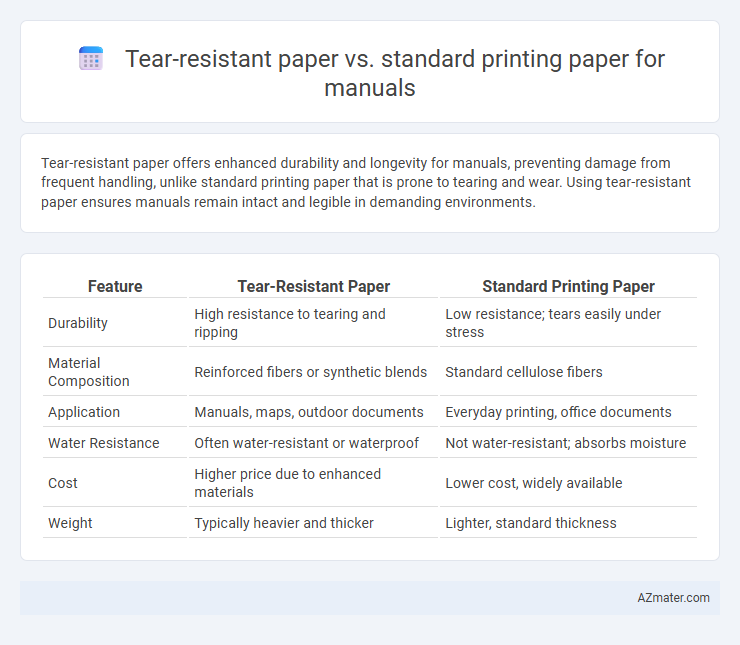Tear-resistant paper offers enhanced durability and longevity for manuals, preventing damage from frequent handling, unlike standard printing paper that is prone to tearing and wear. Using tear-resistant paper ensures manuals remain intact and legible in demanding environments.
Table of Comparison
| Feature | Tear-Resistant Paper | Standard Printing Paper |
|---|---|---|
| Durability | High resistance to tearing and ripping | Low resistance; tears easily under stress |
| Material Composition | Reinforced fibers or synthetic blends | Standard cellulose fibers |
| Application | Manuals, maps, outdoor documents | Everyday printing, office documents |
| Water Resistance | Often water-resistant or waterproof | Not water-resistant; absorbs moisture |
| Cost | Higher price due to enhanced materials | Lower cost, widely available |
| Weight | Typically heavier and thicker | Lighter, standard thickness |
Introduction to Tear-Resistant and Standard Printing Papers
Tear-resistant paper is engineered with reinforced fibers to withstand frequent handling, making it ideal for manuals that require durability and longevity. Standard printing paper, typically composed of wood pulp, offers a cost-effective solution but lacks the strength to endure repetitive use without damage. Selecting tear-resistant paper enhances manual lifespan, reducing the need for frequent replacements in high-usage environments.
What is Tear-Resistant Paper?
Tear-resistant paper is a specially engineered material designed to withstand rough handling and frequent use, making it ideal for manuals that require durability. Unlike standard printing paper, which is prone to ripping and damage, tear-resistant paper incorporates synthetic fibers or is coated with protective layers to enhance strength and longevity. This type of paper maintains print clarity and resists tearing even under stress, ensuring manuals remain intact and readable in demanding environments.
Key Features of Standard Printing Paper
Standard printing paper offers reliable smoothness and consistent brightness, ensuring clear text and image reproduction for manuals. Its moderate thickness balances durability with flexibility, making it suitable for everyday use without tearing easily under normal handling conditions. The paper's compatibility with most printers and affordability make it a practical choice for mass-produced manuals where cost efficiency is important.
Durability Comparison: Tear-Resistant vs Standard Paper
Tear-resistant paper offers superior durability compared to standard printing paper, with enhanced fiber bonding that resists tearing, making it ideal for frequent handling and extended use in manuals. Standard printing paper tends to tear easily under stress, reducing the lifespan of manuals subjected to constant flipping and rough use. Tear-resistant paper retains structural integrity under repeated handling, ensuring manuals remain intact and readable over time.
Cost Analysis: Which is More Economical?
Tear-resistant paper typically costs 30-50% more than standard printing paper but offers greater durability, reducing replacement frequency and long-term expenses for manuals used in harsh environments. Standard printing paper, while cheaper upfront, may incur higher costs over time due to frequent reprints and damaged materials, especially in high-use or outdoor settings. Evaluating total lifecycle cost, tear-resistant paper proves more economical for manuals requiring longevity and frequent handling.
Printing Compatibility and Performance
Tear-resistant paper offers superior durability and withstands frequent handling without compromising print quality, making it ideal for manuals used in harsh environments. Standard printing paper provides reliable ink absorption and sharp text clarity but is prone to tearing and wear over time, especially with heavy use. Compatibility with most printers remains consistent for both types, though tear-resistant paper may require adjustments in printer settings to optimize performance and prevent jams.
Environmental Impact and Sustainability
Tear-resistant paper used in manuals offers enhanced durability, reducing the need for frequent replacements and thus lowering overall paper consumption compared to standard printing paper. Its longevity contributes to less waste generation and minimizes deforestation by extending the lifecycle of printed materials. Furthermore, many tear-resistant papers incorporate recyclable or biodegradable components, supporting sustainable practices and reducing environmental impact.
Ideal Use Cases for Manuals
Tear-resistant paper offers superior durability for manuals used in demanding environments such as industrial settings, fieldwork, or outdoor applications where exposure to moisture, rough handling, and frequent use is common. Standard printing paper is suitable for manuals in controlled office or home environments where longevity and resistance to physical damage are less critical. Choosing tear-resistant paper ensures information remains legible and intact over time, reducing the need for frequent replacements in harsh conditions.
User Experience and Handling
Tear-resistant paper for manuals offers enhanced durability, significantly reducing the risk of damage from frequent handling and improving longevity in high-use environments. Users benefit from its robust texture, which maintains legibility and structural integrity even under rough conditions, unlike standard printing paper that easily tears or wrinkles. This improved resilience translates to a superior handling experience, ensuring manuals remain intact and readable throughout their lifespan.
Final Verdict: Choosing the Best Paper for Manuals
Tear-resistant paper offers superior durability and longevity for manuals, making it ideal for frequent handling and harsh environments compared to standard printing paper, which is prone to wear and damage. Its enhanced resistance to tearing, moisture, and creasing ensures the manual remains intact and readable over time, reducing replacement costs and improving user experience. For manuals requiring extended usability and resilience, tear-resistant paper is the optimal choice, while standard paper suits short-term or low-use documents.

Infographic: Tear-resistant paper vs Standard printing paper for Manual
 azmater.com
azmater.com